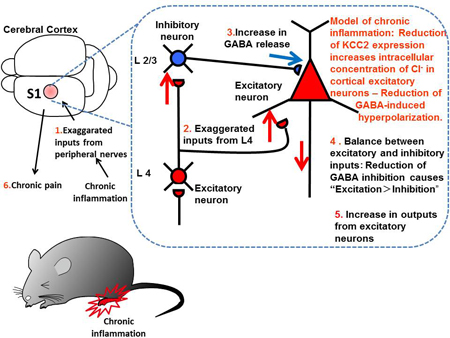Chronic pain is induced by exaggerated neuronal activities in the central nervous system. In addition to the spinal cord, several researches clarified that cortical areas, including primary somatosensory cortex (S1), also contribute to processing of pain information in chronic pain. In the present study, to identify the role of the S1 layer 2/3 (L2/3) inhibitory neurons, which modulate the activities of excitatory neurons, in chronic pain, we combined several methods, including in vivo two-photon calcium imaging, behavior, and electrophysiology. We found inhibitory neuronal activities were increased in the S1 and inhibitory inputs increased in chronic pain condition. However, the net effect of GABA inhibition was insufficient to alleviate exaggerated excitatory activities and chronic pain behavior due to reduction of expression of potassium-chloride co transporter KCC2, which maintain intracellular chloride concentration in neurons. This study may shed light on the central mechanisms of chronic pain and provide a new efficient therapeutic strategy against chronic pain by focusing on cortical areas.
Enhanced GABAergic Activity in the Mouse Primary Somatosensory Cortex Is Insufficient to Alleviate Chronic Pain Behavior with Reduced Expression of Neuronal Potassium-Chloride Cotransporter.
Eto K, Ishibashi H, Yoshimura T, Watanabe M, Miyamoto A, Ikenaka K, Moorhouse AJ, Nabekura J.
J Neurosci. 2012 ;32(47):16552-16559.

Chronic inflammation of peripheral tissues enhanced inputs from peripheral nerves to the primary somatosensory cortex via spinal cord and thalamus (1). These exaggerated inputs enhanced inputs from layer 4 excitatory neurons to layer 2/3 (L2/3) excitatory and inhibitory neurons (2), which in turn facilitated release of GABA to excitatory neurons (3). In excitatory neurons, reduction of expression of potassium-chloride cotransporter increased concentration of intracellular chloride, which in turn attenuated GABA inhibition. Thus, GABA inhibition was insufficient to offset of exaggerated outputs from L2/3 excitatory neurons (5) and chronic pain behavior (6).